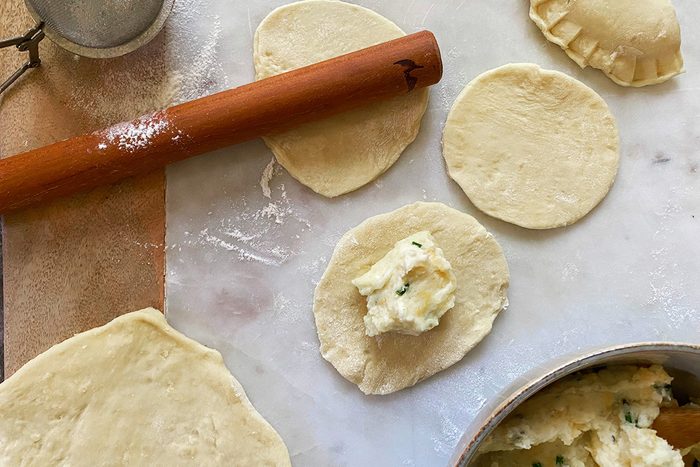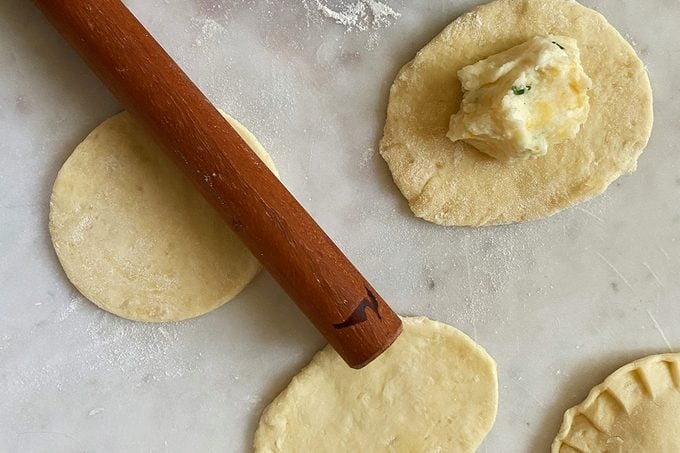You Need a Mini Rolling Pin in Your Kitchen—Here’s Why
Updated: Nov. 16, 2021

Dumpling fanatics and bakers, listen up! Your kitchen isn't complete without a mini rolling pin. Learn why you need this tiny tool.
Our editors and experts handpick every product we feature. We may earn a commission from your purchases.
I’ve got a pretty good collection of rolling pins in my kitchen. I have a classic one handed down from my great-grandmother, a French-style pin that I love for making pie crust and even a fancy embellished rolling pin—a great gift from my sister-in-law.
Until recently, though, my collection was incomplete. I was missing one last tool: a mini rolling pin!
What’s a mini rolling pin used for?
A mini rolling pin, sometimes called a dumpling pin or dumpling dowel, is mostly used for—you guessed it—dumplings. Dumpling dowels are much shorter and slimmer than your typical rolling pin. They’re often around eight inches long and less than an inch in diameter.
So why do you want a smaller rolling pin for dumplings like gyoza and pierogi? These dumplings are made by loading up small rounds of dough with some tasty stuffing. The doughs for these dumplings are super stretchy so they can hold all that filling. That means that once the dough is cut out, it needs to be rolled again to stretch it out.
You can use a standard rolling pin, but it can be a bit unwieldy rolling a foot-long rolling pin over a three-inch round of dough. A smaller rolling pin, however, is just the right size for giving these rounds of dough a quick press.
So how well does it work?

When I learned about the gap in my set of rolling pins, I immediately rectified the situation. For less than $15, I got this pretty cherrywood dumpling dowel from Minnesota maker Knot Woodpecker.
Once this compact tool was in my grasp, I knew it was time to stir up a batch of pierogi. The dough for my signature pierogi is pretty elastic and I had struggled using a long rolling pin before, so I was excited to see how this would change the pierogi game for me.
After rolling out a sheet of dough (I still use a traditional rolling pin for that), I cut out rounds of dough. As always, this stretchy dough snapped back into a smaller circle. It was time to use this dumpling dowel.
How was it? It was a dream! Making these Polish dumplings is a time-consuming practice (unless you invite pals over for a pierogi party/assembly line). This tool made rolling out the dough easier and less cumbersome. I wasn’t squishing other bits of dough or knocking over my canister of flour while struggling with that giant French rolling pin.
For a pierogi fanatic like me, this tiny tool was an absolute game-changer.
Who needs a small rolling pin?
For me, someone who makes pierogi often, buying a mini rolling pin was a no-brainer. But it’s not just for serious pierogi preppers. If you make pierogi, potstickers or other persnickety dumplings—even if it’s just once a year—this is a must-have. It’s affordable and compact—you’ll hardly notice it when you add it to your gadget drawer or utensil crock.
But dumplings are just the tip of this iceberg. You can use a small rolling pin for other kitchen tasks:
- Decorating: If you love intricate decorations for cakes, cupcakes or cookies, you’ll find this small pin pretty handy. It’s great for rolling out fondant, gum paste and modeling chocolate for delicate decor.
- Molding: While our Test Kitchen loves using a handy tamper for making cookie cups for tassies, you can also use the blunt end of this rolling pin to shape the dough.
- Shaping: Ever wonder how cookies like these Lacy Brandy Snaps get their shape? They need to be carefully formed, typically with the handle of a wooden spoon. However, a mini rolling pin works even better. It gives you a bit more room inside for more filling.
As a kitchen multi-tasker, you’ll find plenty of reasons to expand your selection of rolling pins to include this pocket-sized version.
